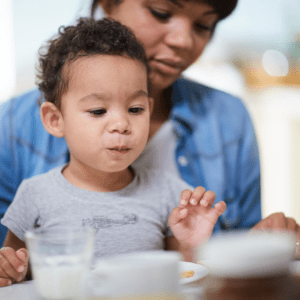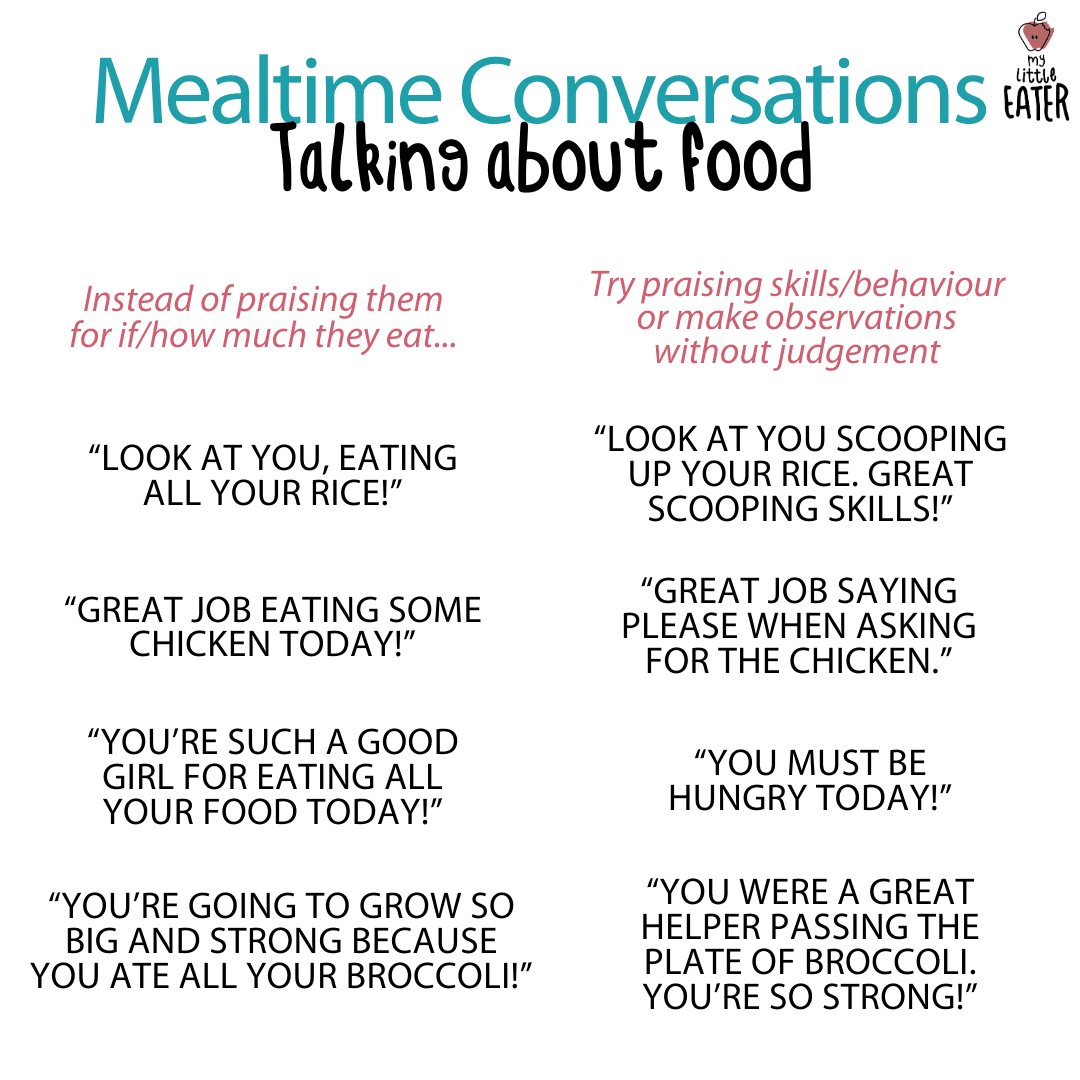
Last week, I talked about the importance of shifting mealtime conversations away from food and onto topics that are bonding, enjoyable, and create happy environments and conversations. This is one of the major things to think about when figuring out what changes you can make at mealtimes to improve picky eating. Talking to your toddler or preschooler about how much food they’re eating or not eating, what to eat next or to try a bite of, or even just intently watching your child eat or praising them for eating something you really wanted them to, can all be forms of feeding pressure that make picky eating worse. We really want to keep pressure away from mealtimes as much as possible. Read this post for more info on why.
Inevitably, there are going to be times when discussing food is required, and quite honestly, invited! Talking about food as part of a mealtime conversation is inevitable and there’s a way to do that in order to make it educational and interesting vs. overbearing and boring. I also want to address the concern of how to encourage your child to eat something and how to praise them for improvements they’re making, WITHOUT pressuring them. I will cover some things to say/not say when you want/need to talk about food and their eating behaviour, so that you will be encouraging them and keeping them motivated, while avoiding any negative side effects.
Let’s dig in.
Tip #1: Praise their skills, not their eating
If you find yourself obsessing over how much your child eats and praising them when they do eat by saying something like: “Wow, you’re such a good girl for eating all your carrots!” You might just be sending the message that they have to eat more food than they want/need to in order to impress you. After all…that’s what good girls and boys do. This can place a lot of pressure on them to make you proud of them and can teach them to overeat and override mindful eating skills.
When I tell parents that we even want to avoid obvious forms of positive pressure at meals, they’re often like… “Does that mean I can’t praise my child for anything? How do I encourage them to eat if they never get praise for it?”
The answer?
Praise/comment on their skills, their mind, their general behaviour, and general observations….NOT their eating habits and how it relates to their moral attributes.

Here’s how…
Instead of saying “You’re such a good girl for eating all your food today!”
Try saying “You must be hungry today!”
Instead of saying “Look at you, eating all your rice!!”
Try saying “Look at you scooping up your rice. Great scooping skills!”
Instead of saying “You’re going to grow so big and strong because you ate all your broccoli today!”
Try saying “You were an excellent helper passing the plate of broccoli. You’re so strong!”
Instead of saying “Oh I like that you want to eat some chicken today!”
Try saying “Great job saying please when asking for the chicken.”
Instead of saying “You’ve had enough bread for this meal.”
Try saying “You’ve been very patient waiting for the bread to be passed around.”
Instead of saying “Why aren’t you eating any of your peas today?”
Try saying: “I noticed you didn’t care for the peas today.” (with no judgement as to the reason why)
I could go on and on.
Notice how we shift from praising anything to do with how much, or what type, of food they ate as being a good or bad thing…into praising them for skills they’re working on, their manners, or general behaviour or observations (with no judgement tied to it). You are now making it very obvious that a) food is not going to be a topic that can be used for control (either by you or your child) and b) it’s pleasant to be at the table! Your child thinks “I get praised when I do xyz” which improves their mood at the table and opens up the opportunity for them to willingly try to eat!
Tip #2: Be neutral in your description and mention of food
The most effective thing I’ve found to keep pressure away and yet get conversations going about food, is talking about it in a neutral, factual way. No trying to sway or convince them, over-exaggerate the way you talk about a food, or over-highlight one food instead of another without reason. For example, when presenting food at the table, saying:
“Oooh look at these delicious peas, yummy! They look so good! Don’t they look good?” This risks the possibility your toddler interprets this as you trying to convince/pressure them to eat those peas.
Instead, factually state what it is. For example:
“We’re having peas, chicken, and rice tonight.”
If they ask for more information, you can say:
“The chicken is marinated in a soy sauce.”
Other add-ons to this answer, if you feel like they need or want more information, could include:
“This is the same sauce Grandma uses when she makes her salmon.”
“Soy sauce is a bit salty.”
Other neutral phrases around food could be:
“The peas are bright green and harder than usual today.”
“I used a spicy seasoning on the peas today. Do they taste spicy to you?”
Salty, green, spicy, and hard are neutral descriptions of food. Describing food for it’s properties and characteristics is one of the best ways you can make sure you’re staying neutral when talking about food. Try and see how this contrasts a phrase like the one below:
“Peas are so healthy for you. We should all have at least one green food like peas on our plate.”
“The seasoning on the peas is amazing! You’re going to love it.”
Do you see a difference?
Now, it doesn’t mean you can’t ever show emotion around a food, like showing when you enjoy the taste of something, or stating that you don’t like a food yet. Rather, it’s more about WHY you’re saying what you’re saying, ‘cause the intention will always shine through. This can be something we overthink a lot. But don’t. We really just want to try and avoid words or ways of talking about food that are meant to influence our child’s eating habits. So just ask yourself: “Is what I’m saying for the purpose of trying to convince my child to eat more, less, or differently, from how they normally would? Or am I just sharing my personal opinion of MY food?” If it’s the former, think twice. If not, go ahead and say/explain things the way you were! And guess what? The side effects of this are that they will be more likely to learn about a food and be more keen to eat something, that they might not have, had they felt pressured to.
Tip #3: Make it fun with games and education!
Playing a simple game at the table can be another great way to teach about food, bring it up as a topic at the table, and draw attention to it, without making a child feel like they HAVE to eat it. Plus, it makes mealtimes much more fun for them!
Games like “I spy” work well, for example:
- “I spy with my little eye, something that is round.”
- “I spy with my little eye, something that is red.”
- “I spy with my little eye, something that is sticky/crunchy/mushy.”
It’s a great way to build on their vocabulary and have them exploring food, and mealtime related items, without pressuring them to eat! When kids are taught the full range of words used to describe food, you teach them how to really taste a food to decipher all the different properties of it, vs. tasting it with the sole outcome of declaring whether it tastes “good” or “bad”. Sometimes, even when a food does taste good, kids are hesitant to say that because they think… “If I say it’s good, mom will make me eat more of it!” So they hold back either tasting at all, or admitting that it’s not that bad. If we instead teach them to taste a food to describe it, for example, as stretchy, bitter, crumbly, or lumpy, we can remove any barriers to tasting in general. This way they know that they’re just tasting to learn about it and we, as parents, generate more information from our kids about their preferences (which leads to more discussion and learning)!
I also strongly recommend checking out my blog post on food exploration and food play. It’s such a game changer when you can have your kids exploring a food with all five senses in a way that takes the “new” out of a food, and increases the number of exposures to it and meets kids where they are without having to say “take a bite”. My Feeding Toddlers online course is full of games, scripts, and ideas for ways to take your meal times from food and pressure-centric, to bonding and fun-centric. If you have a picky eater and you want the full, step-by-step plan on how to feed them healthily and happily so they overcome picky eating, you’ve got to check out the course!
Here’s what one mom had to say:
I feel like since I’ve taken your toddler course things have been so much less stressful around here. My daughter is agreeable and she eats her meals without a fight. I’ve been calmer and understanding of why she does what she does and trust her more. We feel like a new family! Thank you, thank you!
If you also want stress-free mealtimes and confidence knowing how to raise a healthy eater, join the thousands of families that have seen mealtime transformation through the Feeding Toddlers course!





